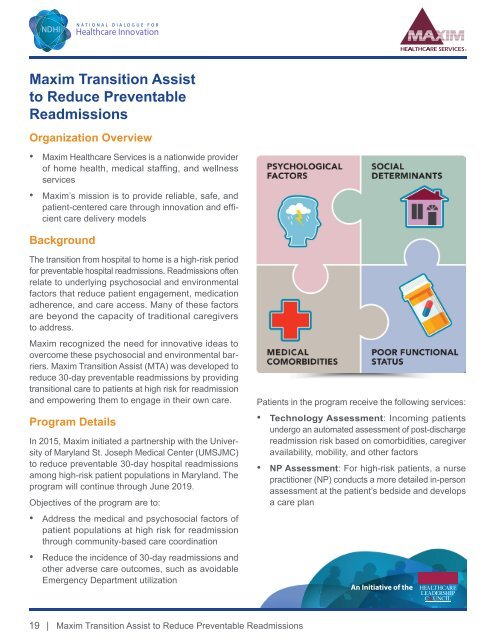VIable
HLCCompendium
HLCCompendium
Create successful ePaper yourself
Turn your PDF publications into a flip-book with our unique Google optimized e-Paper software.
NDHI<br />
NAT IONAL DIALOGUE FOR<br />
Healthcare Innovation<br />
Maxim Transition Assist<br />
to Reduce Preventable<br />
Readmissions<br />
Organization Overview<br />
• Maxim Healthcare Services is a nationwide provider<br />
of home health, medical staffing, and wellness<br />
services<br />
• Maxim’s mission is to provide reliable, safe, and<br />
patient-centered care through innovation and efficient<br />
care delivery models<br />
Background<br />
The transition from hospital to home is a high-risk period<br />
for preventable hospital readmissions. Readmissions often<br />
relate to underlying psychosocial and environmental<br />
factors that reduce patient engagement, medication<br />
adherence, and care access. Many of these factors<br />
are beyond the capacity of traditional caregivers<br />
to address.<br />
Maxim recognized the need for innovative ideas to<br />
overcome these psychosocial and environmental barriers.<br />
Maxim Transition Assist (MTA) was developed to<br />
reduce 30-day preventable readmissions by providing<br />
transitional care to patients at high risk for readmission<br />
and empowering them to engage in their own care.<br />
Program Details<br />
In 2015, Maxim initiated a partnership with the University<br />
of Maryland St. Joseph Medical Center (UMSJMC)<br />
to reduce preventable 30-day hospital readmissions<br />
among high-risk patient populations in Maryland. The<br />
program will continue through June 2019.<br />
Objectives of the program are to:<br />
Patients in the program receive the following services:<br />
• Technology Assessment: Incoming patients<br />
undergo an automated assessment of post-discharge<br />
readmission risk based on comorbidities, caregiver<br />
availability, mobility, and other factors<br />
• NP Assessment: For high-risk patients, a nurse<br />
practitioner (NP) conducts a more detailed in-person<br />
assessment at the patient’s bedside and develops<br />
a care plan<br />
• Address the medical and psychosocial factors of<br />
patient populations at high risk for readmission<br />
through community-based care coordination<br />
• Reduce the incidence of 30-day readmissions and<br />
other adverse care outcomes, such as avoidable<br />
Emergency Department utilization<br />
An Initiative of the<br />
19 |<br />
Maxim Transition Assist to Reduce Preventable Readmissions


